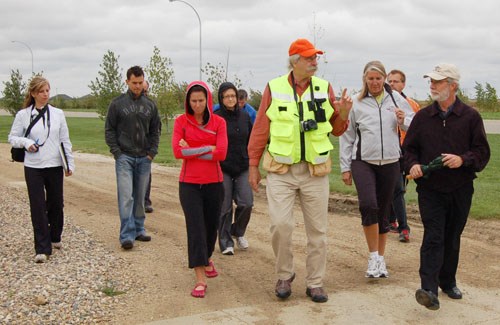Several community members came together recently to help make Weyburn a more "walkable" city during a three-day workshop by renowned community consultant Dan Burden.
Burden visited Weyburn from August 30 to September 1 in order to give his professional opinion on making the city more suited to active transportation and therefore encourage walking, jogging, cycling and an active lifestyle for residents.
Weyburn In Motion brought Burden to the city, with the help of Saskatchewan In Motion, Sun Country Health Region and the Community Initiative Fund, to view Weyburn and meet with city planners in order to direct future development towards a more "walkable," bicycle-friendly, socially engaging and welcoming city.
The Dan Burden Walkable and Liveable Communities Workshop included a walking audit of the city and a public presentation on August 31. Burden will generate an action plan for Weyburn based on his findings by the end of September.
"The main goal of the action plan is to increase the use of active transportation in our community," said Weyburn In Motion chair Susan Nedelcov-Anderson. "One way to do this is to promote physical activity. Another critical piece of that is making sure we have the structures in place so that physical activity is an easy choice."
Nedelcov-Anderson referred to the In Motion initiative that had blue bike racks installed downtown, making cycling easier for residents who want to ride their bicycles to do their shopping.
"Also, building sidewalks where there are no sidewalks might allow people to walk out to Tim Hortons, for example, rather than drive their car," said Nedelcov-Anderson.
Burden contended that the ways in which cities are built nowadays are centered on automobile transportation, rather than non-motorized transportation.
"The whole notion of walk-ability didn't exist 30 years ago," said Burden. "We've made cities unsuitable for walkers. Everything we were doing before was basically for the auto but now it's for the people."
Burden said that although Weyburn has some very green neighbourhoods, beautiful boulevards and a very active downtown, a few things did stick out.
"What really out-trumped that, unfortunately, was how many streets were just nothing but vast acres of asphalt and concrete butted up against vast parking lots," said Burden. "The good news is you can convert that."
Burden has championed the use of roundabouts and mini-circles in his city designs as a way to slow down traffic without the need for four-way stop intersections. He said that slowing down traffic will make residents feel more comfortable when walking and cycling, especially seniors and children. Another way to slow down traffic and encourage walking, according to Burden, is to narrow streets and widen sidewalks to at least five-feet.
Burden noted that the newer developments in the north end of town are making trail walking uncomfortable for walkers.
"All the houses have their backs facing the (Tatagwa) trails," said Burden. "Houses should be built to look over the trails so that walkers feel more secure."
Burden praised the City for the development of Tatagwa Parkway, noting that besides Ottawa, he could think of no other city with such an impressive trail system. He also praised the sense of safety that Weyburn enjoys.
"I truly believe this is the safest community I've ever come to in terms of personal security and in terms of traffic and I've been to 3,000 communities," said Burden. "So why aren't people walking? I think it's all cultural."
As for the development of the former Souris Valley Hospital area, Burden said he thought it could have beautiful living spaces as well as lots of green space for the public.
Burden is the creator of the Walkable and Liveable Communities Institute, focused on engaging city planners to successfully rebuild blocks, neighbourhoods and towns. In 2001 he was named by Time Magazine as "one of the six most important civic innovators in the world." He has more than 35 years experience creating liveable communities through a focus on non-motorized transportation.




